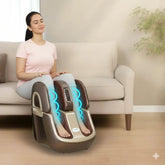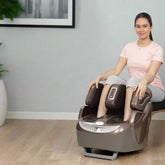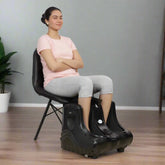Many people suffer from a sharp pain running down the leg when they stand up, a tingling sensation while sitting, or a heaviness that makes walking difficult. It could be due to a neurological condition called sciatica, where the problem begins in your lower spine but travels all the way down to your toes.
Sciatica is not just another back or leg ache. It’s a neurological condition that can impact your mobility, posture, and quality of life if not understood and managed on time. Let’s try to understand the science behind sciatica, its causes, symptoms, and evidence-based relief techniques so you can make informed choices about your body and wellness.
What Exactly Is Sciatica?

Your sciatic nerve is the longest and thickest nerve in your body. It begins in the lower spine (lumbar region), passes through the buttocks, travels down the back of each thigh, and extends all the way to the feet.
The issue of Sciatica occurs when sciatic nerve becomes compressed or irritated, causing pain that radiates along its pathway, typically on one side of the body.
The Scientific Explanation Of Sciatica
To understand sciatica deeply, you need to know what happens beneath the surface.
The spinal column is made up of vertebrae separated by soft discs that act as cushions. When one of these discs slips out of place (called a herniated or bulging disc), it can press on the sciatic nerve roots that exit the spine.
This mechanical pressure, combined with chemical inflammation from disc material, irritates the nerve leading to pain signals that travel down the leg.
It’s not just mechanical compression; inflammation plays a key role. Inflammatory molecules like prostaglandins and cytokines heighten the sensitivity of the nerve, which is why the pain can feel intense even with small movements.
Common Causes of Sciatica
- Herniated Disc (Slipped Disc): The most frequent cause is the soft inner material of a spinal disc protrudes and compresses the nerve root.
- Degenerative Disc Disease: With age, spinal discs lose hydration and elasticity, reducing the cushioning between vertebrae and increasing the risk of nerve compression.
- Spinal Stenosis: The spinal canal narrows, squeezing the nerve roots. This is more common in adults over 50.
- Piriformis Syndrome: A lesser-known cause is when the piriformis muscle (deep in the buttocks) spasms or tightens, it can press against the sciatic nerve.
- Poor Posture & Sedentary Lifestyle: Long hours of sitting, weak core muscles, and incorrect posture increase spinal pressure and reduce blood circulation, leading to chronic nerve irritation.

Common Symptoms of Sciatica
You might be suffering from sciatica if you feel:
- Pain radiating from the lower back to the leg (usually one side)
- Burning, tingling, or “pins and needles” sensations
- Pain that worsens when sitting, coughing, or sneezing
- Weakness in one leg or foot
- Difficulty standing up straight or walking comfortably
Stress can worsen sciatica. Chronic stress causes muscle tension, especially in the lower back and hips. This tension compresses the spine and restricts nerve flow.
Additionally, cortisol (the stress hormone) increases inflammation, amplifying pain perception.
Natural and Effective Relief Techniques For Sciatica
1. Heat and Cold Therapy
Heat therapy improves circulation, reduces stiffness, and soothes tight muscles. Cold therapy helps reduce inflammation and nerve swelling after activity. Alternating between the two can provide dual benefits.
2. Stretching and Mobility
Regular stretching of the piriformis, hamstrings, and lower back helps restore flexibility and alignment. Yoga poses like Pigeon Pose, Cat-Cow Stretch, and Knee-to-Chest are particularly helpful.
3. Posture Correction
A neutral spine posture while sitting or working prevents chronic nerve compression. Use ergonomic chairs, lumbar cushions, and take frequent movement breaks.
4. Targeted Massage Therapy
Massage helps relax tight muscles, improve blood flow, and reduce nerve compression. Using a deep-tissue massager such as the JSB Leg & Back Massager, can target deep muscle layers, releasing the pressure around the sciatic nerve.
When to Seek Professional Help
You should consult a doctor or physiotherapist if:
- Pain persists beyond 2–3 weeks despite home care
- You experience numbness, weakness, or loss of bladder/bowel control
- Pain radiates below the knee or disrupts sleep
- Early diagnosis ensures faster recovery and prevents chronic nerve damage.
Long-Term Healing Philosophy
True sciatica recovery is not just about pain relief; it’s about spinal health restoration.
That means adopting daily habits that nurture your back:
- Maintain a healthy body weight
- Stretch daily, especially after long sitting hours
- Invest in ergonomics at home and work
- Use intelligent recovery tools like massage devices to support muscle relaxation and circulation
Heal the Source, Not Just the Symptom
Sciatica is a reminder from your body to slow down, move mindfully, and take care of your spine. When you approach healing with awareness, combining medical advice, physical care, and smart recovery tools, you don’t just manage the pain; you restore balance and freedom of movement.
At JSB Wellness, we believe in empowering you with knowledge and science-backed self-care. Because true wellness isn’t about quick fixes, it’s about understanding what your body is telling you and responding with care.











